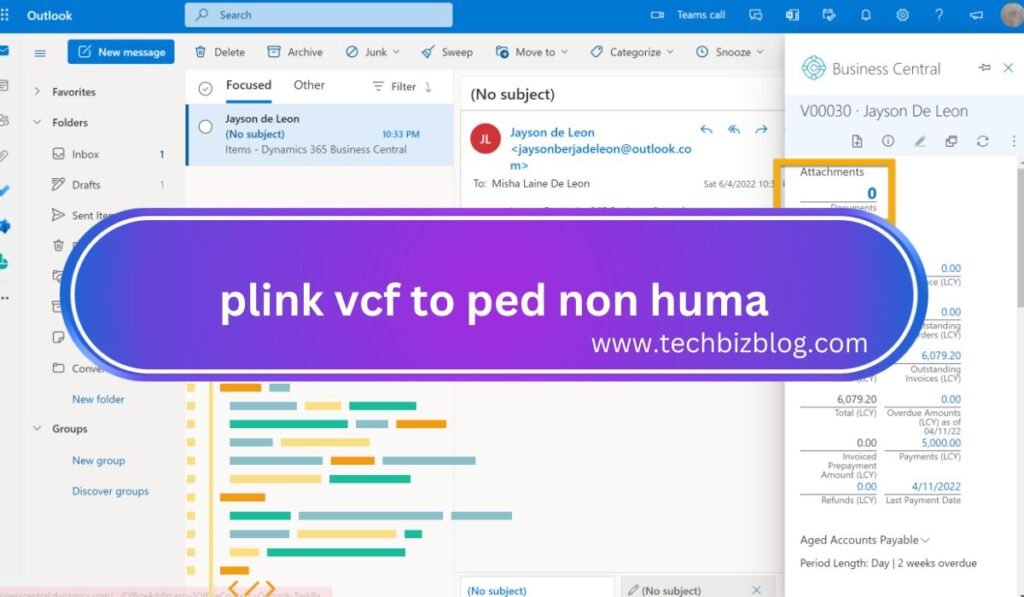This conversion will be imperative, while doing any genetic study involving conversions of VCF to PED files in bioinformatics, especially in non-human species. Plink vcf to ped non huma is one of the commonly used tools for whole-genome association studies that offer such facilities. However, dealing with non-human data is more complex because of the reference genomes, markers, and other species-specific data. The following tutorial was done in a step-by-step manner for the conversion of VCF to PED using PLINK for data other than humans; considerations, challenges, and best practices were also identified.
VCF PED Files Basics Understanding VCF and PED Files

Overview of VCF Files
The Variant Call Format is the standard bioinformatics file format that represents gene sequence variations, including single nucleotide polymorphisms and insertions/deletions. These files contain meta-information lines, a header line, and data lines, each representing a genomic position along with the observed variation. VCF files are extremely important in genetic studies as they will give full details about the genetic variations across different samples.
PED File Overview
A PED file is a simple text file used in studies in genetics to describe the pedigree or family relationships and phenotypes and genotypes of participants. This format is useful in association studies where understanding the pattern of inheritance and variation across families or populations would be relevant. PED files, together with MAP files, are two files used by PLINK in performing various genetic analyses.
Importance of VCF to PED Conversion
All genetic studies, such as carrying out a genetic association analysis with PLINK, demand VCF file conversion into PED format. Conversions into PED format allow manipulation and analysis of genetic data with ease to study the pattern of inheritance, population genetics, and disease associations. In non-human species, this conversion is one of the major uses in the study of genetic diversity, evolutionary biology, and breeding programs.
PLINK: A Condensed Summary
Features and Capabilities of PLINK
PLINK-also a free, open-sourced software-is widely used for whole-genome association analysis and population-based linkage analysis. It accepts almost all major modern file formats such as VCF and PED, with a long list of options regarding data management, quality control, testing of associations, and so on. PLINK is quite efficient and speedy, hence mostly favored in large-scale genetic studies.
Application of PLINK in Nonhuman Genetics
Although PLINK was originally designed for human genetic studies, it has been modified to apply in non-human species. The majority of researchers in the fields of livestock, plants, or model organisms use PLINK for basic genetic analyses, association studies, and investigation of evolutionary relationships. These make the tool valuable in the study of non-human genetics.
Challenges in Converting VCF to PED for Non-Human Data
Differences of Reference Genomes
One of the major difficulties in converting VCF to PED for non-human data is the difference of reference genomes. Unlike in human genetics, where the reference genome is well established, non-human species can have several reference genomes, or their genome is less well-annotated. Such discrepancy can make the process of conversion complex because one has to take a great deal of pain while choosing the reference genome and alignment parameters.
Non-Human Marker Processing
Markers in non-human species often represent significantly different frequencies and distributions across the genome compared to humans. These differences require special handling in the course of conversion so that the resulting PED file correctly reflects genetic variation across the species under study.
Species-Specific Data Considerations
Except for humans, the basis of a genetic study usually involves species-specific data, including unique chromosomal structures, different levels of genetic diversity, and variable rates of mutations. These should be appropriately accommodated in the course of conversion to avoid biases or inaccuracies in analysis.
Converting VCF to PED Using PLINK: A Step-by-Step Guide

Installation and Setup of PLINK
First, one has to ensure that PLINK is installed on the system. PLINK can be installed on Windows, macOS, and Linux. Installation may be guided by visiting the official website for PLINK. Once PLINK is added, familiarize yourself with the command-line interface since the conversion will be done through it.
Preparation of VCF Files for Non-Human Data
- Alignment to the appropriate Reference Genome: Alignment of the VCF to an appropriate reference genome is of vital importance in case of non-human species. One will incur some risks, such as wrong genotype calls during conversion, especially in cases where there is mismatch in the reference genome.
- Quality Control: Quality control is done on the VCF. This involves the removal of low-quality variants. This may include the filtering out of variants with low depth, high missingness, or poor quality scores.
Annotation of the VCF with gene name, functional consequence, and population frequency will provide context that is useful in downstream analyses.
Conversion Process: Command-Line Instructions
The following command can be used to convert a VCF file to PED format using PLINK:
plink --vcf input_file.vcf --recode --out output_file
input_file.vcfis the path to your VCF file.
input_file.vcfis the path to your VCF file.output_fileis the desired name for the output PED file.
This command generates two output files. The first is the PED file, which is represented by output_file.ped, and the second is a MAP file, expressed as output_file.map. The information in the MAP file contains the genetic markers used as well as the position of each marker on the reference genome.
Checking Conversion for Accuracy
Following conversion, it is necessary to check that the PED file created is accurate. Verification may be done by:
- Variant Count Comparison: The number of variants in the PED file should match that found in the original VCF.
Checking Genotype Calls: Take a few variants randomly and look into the PED file for genotype calls and cross-check with VCF to confirm consistency. - Data Visualization: Visualize the genetic data by using tools like PLINK or R in order to detect any anomalies or inconsistencies.
Also read more: kääbntäjä
Also read more: Pyle mxu63bt
Best Practices for Non-Human Data Conversion
Quality Control Measures
Good quality control is paramount to good conversion. Examples of this are filtering out low-quality variants, using consistent reference genomes, and checking for population stratification. Further quality control and variant filtering can be done with advanced packages such as GATK or BCFtools.
Handling Missing Data
Missing data are common in genetic studies and even more so in non-human species whose genomes have not been as well characterized. In handling missing data:
Imputation: In this respect, imputation methods will estimate the missing genotypes from known haplotypes and population data. The filtering of individuals or variants with too much missing data is an additional consideration as such may lead to biases in the analysis. Sensitivity Analysis: Final sensitivity analyses that will allow an assessment of the results as a function of missing data would be done.
Optimizing Conversion for Different Species
Some optimization during the process of conversion may be necessary and specific to other non-human species. For instance,
- Livestock: Focus on markers linked with the trait of interest, which may include milk production or disease resistance.
- Plants: Polyploidy or structural variants may affect the conversion process
- Model Organisms: Conversion will be most precise for species with a well-annotated reference genome and when utilizing species-specific tools.
Common Errors and Troubleshooting
Error Messages with their Solutions
During conversion from VCF to PED, you might encounter the following error messages:
- Reference allele mismatch: This is one of the errors whereby your VCF file’s reference allele does not match that of the reference genome. To fix this error, you need to make sure that your VCF file should be aligned with the correct version of the reference genome. Additionally, you may use tools such as bcftools in properly aligning the mismatch.
- “Invalid chromosome identifier”: Some non-human species have specific chromosome identifiers that may not be recognized by PLINK. In that case, this can easily be overcome by switching to a different VCF in use with standard chromosome identifiers or by revising the parameters of PLINK such that it can deal with non-standard identifiers.
Tips for Troubleshooting Thoroughly and Efficiently
- Check Documentation: First of all, the best place to look regarding solutions about PLINK is the PLINK documentation and online forums.
Test Data: Start with a small subset of your data to test the conversion process before scaling up to the full dataset. - The Community: Share experiences and seek advice regarding new and challenging file formats with the wider bioinformatics community using online forums, mailing lists, or social media focused on bioinformatics.
FAQ
Does PLINK support any non-human species?
Although PLINK supports a wide variety of non-human species, for its analytical power, it would require a well-annotated reference genome and proper quality control. For non-model organisms, one may be advised to modify the conversion process based on species-specific genetic features.
What are the limitations in running non-human data in PLINK?
One limitation is that PLINK was initially designed for human genetics, so some functions may not be as perfectly optimized for non-human data. Furthermore, some species may have a particularly unique chromosomal structure or high genetic diversity that requires more preprocessing steps or alternative tools.
How can I ensure the accuracy of the conversion?
Quality control best practices, such as verification of alignment to the reference genome and validation of the resulting PED file against the original VCF file, would be done for accuracy. This would also allow for a number of sensitivity analyses and cross-referencing with other tools for independent verification of the reliability of the conversion.
What are some other options besides PLINK to convert VCF format into PED format?
Other options are VCFtools, GATK and BCFtools that have different options to operate and convert VCFs. Some species-specific programs, such as TASSEL for plants and specific pipelines in livestock, might also be more appropriate for some datasets that are not from human.
How to handle huge VCF files?
In dealing with such large,grunt VCFs it is generally advisable to first convert these into the binary format (.bed) used by PLINK, thus saving lots of memory and reducing processing time. Another option is to parallelize these or run them on the cloud to deal with such massive datasets.
Conclusion
Conversion to PED format for non-human data with PLINK is thus an essential activity in genetic studies. However, the method holds a number of challenges concerning the reference genome and species-specific data; it can give appropriate and reliable conversions if efforts are systematic. Associated with quality control, optimization toward certain species, and troubleshooting from usual errors, Plink vcf to ped non huma can be put into service to make easy large numbers of non-human genetic studies.

